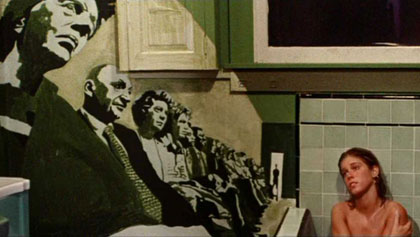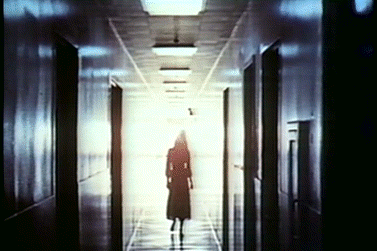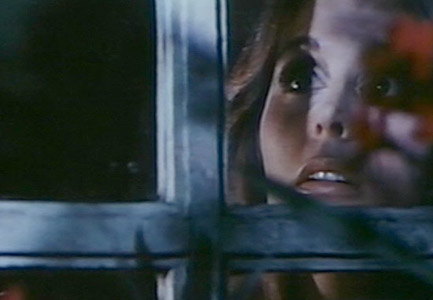By Edward Morrissey
The great impact of H. P. Lovecraft on the horror genre amply justifies the existence of the word, ‘Lovecraftian’. Whatever you think of his merits as a writer, he undoubtedly produced a distinctive vision which could be endlessly riffed on by his successors. But good movies inspired by his works are thin on the ground, and those which evoke his trademark dread are even rarer. 1973’s obscure low-budget Messiah of Evil is arguably one such rare film.
It’s written and directed by Willard Huyck and Gloria Katz, who were behind the equally frightening Howard the Duck and also wrote the screenplay for American Graffiti. Messiah of Evil manages to come across as both an art film and a B-grade horror. Katz and Hyuck, who made the movie fresh out of film school, cite modernist director Michelangelo Antonioni as an influence among others, but the undead attack scenes might make zombie master Lucio Fulci smile in his grave. However the film’s set-up is classic Lovecraft; it’s framed by the heroine Arletty (Marianna Hill) languishing in a mental asylum, recalling the harrowing events of the story and prophesying a near at hand doom.
Her recollected narrative begins with some distressing letters from her reclusive artist father Joseph (Royal Dano). She goes to investigate, much like the protagonist of The Whisperer in Darkness. Like so many of Lovecraft’s central characters, she ends up in a sinister small town, where her father now lives. Other familiar elements include an evil cult and an undefined threat residing in the sea. Whilst searching for her father she falls in with the dandyish Thom (Michael Greer), a collector of legends, and his female ‘travelling companions’: sassy Laura (Anitra Ford) and girlish Toni (Joy Bang). (I apologise for using the word ‘sassy’.)
In my view Messiah of Evil is a very underrated film. It was lost in obscurity upon release but is fortunately enjoying a resurgence (reanimation, you might say) thanks to the internet. You can watch a poor quality print youtube, and a remastered DVD version is available from Code Red. Shooting of the film was never actually finished, so an ending had to be cut together without crucial footage which was supposed to explain the story.
The film’s virtue perhaps lies in its unexpectedness and resistance to categorisation. It combines such seemingly incompatible elements as ‘Lovecraftian’ cosmic terror, psychological horror, surrealism and, as can be guessed from the title, an eschatological undercurrent. I think some of the most interesting aspects of the film can be illuminated by a comparison with Lovecraft. A typical introduction to Lovecraft’s work might credit him with depicting a specifically modern kind of horror. In an almost childlike fashion, he personified our terror at the vast and indifferent cosmos of modern science, in the form of unimaginable beings like the ‘Outer Gods’. Messiah of Evil bears his influence whilst also undercutting it, drawing horror from the modern condition in an entirely different way. Before going into this please bear with me for a few paragraphs, while I raise a few relevant points about the writer.
Lovecraft’s era, the late 19th and early 20th centuries, saw a strong intellectual reaction against modernity from both radical and conservative quarters. Among his contemporaries were backward-looking critics like the philosopher Martin Heidegger and ‘traditionalist’ writer Rene Geunon. Why mention this when talking about a pulp horror author? Like those two thinkers, Lovecraft saw the modern world as vacuous, denuded of meaning and lacking authenticity. He was similarly disdainful of the techno-scientific domination of nature and people which is supposed to demonstrate progress.
In his work, horror comes from what is terribly true, authentic, and not merely human. The alienated, exploitative modern world is not itself a source of horror but just dross to be swept away by the arrival of some eldritch being. The horror is unfailingly ancient. But unlike Heidegger or Guenon, Lovecraft was also impressed by the unsettling implications of modern science. I think that the interesting tension between these two orientations can shed some light on the distinctiveness of Lovecraft’s horror. (The contrast I’ll sketch between a ‘modern’ and ‘pre-modern’ perspective is a dialogical one, for exploring different viewpoints in Lovecraft. I don’t claim that it’s historically apt.)
One respect in which Lovecraft’s stories are set apart from pure SF horror is that in them certain signs and magic words have a symbolic efficacy and sympathetic power. In fact they’re the pretty much the only weapon at the disposal of puny humans, giving them victory in ‘the Dunwich Horror’ and ‘The Case of Charles Dexter Ward’. This reflects a pre-modern view for which the connection between sign and signification is not just arbitrary, and a name can express the essential nature of a thing and thus have power over it. Present day understanding encompasses countless perspectives and ‘conceptual schemes’ but is also aware of their contingency, accepting none as ‘God’s own’ or ‘Nature’s own’ language. Only causal relations exist ‘out there’ in the world, symbolic relations are produced by the human mind.
If a modern scientific perspective attributed any meaning to dreams at all, it would likely be through a psychological or psychoanalytic explanation. In Lovecraft’s story ‘Beyond the Wall of Sleep’ the narrator explicitly rejects “Freud’s puerile symbolism” as a hermeneutic for dreams. In many of his tales, sleep visions provide a glimpse beyond the mundane human world. In ancient accounts such as that of the prophet Joseph or the Mesopotamian hero Atrahasis, dreams contain supernaturally inspired auguries. (Given Messiah of Evil’s other biblical references, the name of Arletty’s father could be taken as an allusion to the former.)
But interestingly, the dream visions in Lovecraft are not cloaked in symbolism. If considered either as an augury or a product of the unconscious, the dream is a text containing symbols which allow for interpretation. Lovecraft has no truck with psychoanalysis, in any case the only truths it could reveal would be about the subject’s psyche. But he is influenced by modern scientific outlook, leaning away from symbolism toward accurate representation. So the dreams that feature in Lovecraft’s stories are more often veridical perceptions rather than texts. In ‘Beyond the Wall of Sleep,’ the narrator believes in the underlying physical nature of thought. He builds a machine which allows him to share Slater’s direct dream vision of another sphere of existence.
The scientifically motivated ideal of accurate and objective representation, which finds aesthetic expression in realism, is evoked in ‘Pickman’s Model’. Here the painter Pickman renders the monsters living below his studio with an ‘almost scientific’ realism. To some extent this describes the author’s own approach. His stories are usually logical rather than dream like, and sometimes laden with scientific or antiquarian detail. The narrator (personal or impersonal) often proceeds like an investigator collating facts and testimony. I’ve drawn a very sketchy distinction between symbolism and direct representation to flesh out some of the interesting tensions in Lovecraft’s horror. The issue is encapsulated by the paradoxical description of the Old Ones’ friezes in ‘At the Mountain of Madness’: they’re stylised and symbolic, but also vividly and realistically detailed.
So much for Lovecraft. It is the differences, rather than the obvious similarities, between his work and Messiah of Evil that are most interesting. Firstly there’s Point Dune itself. A typical Lovecraft town is quaint, creepy and redolent of history. It’s people are removed from many of the effects of modernity, bearing sinister half suppressed legends they’ve passed down through generations. It has an authentic history that somehow connects it to the extramundane word. In contrast the setting of the film is a generic, uglily modern seaside burg. Arriety tells us, “Point Dune doesn’t look any different from a thousand other neon stucco towns.” Particularly interesting are the sites of the zombie attack: the supermarket and movie theatre. Rather than Lovecraftian evil, the sequences evoke a horror rooted in the alienation of modern society. These places are emblematic of capitalist individualism; you rub shoulders with dozens of strangers whilst going about your own business of private consumption.
Then there are the sinister paintings which line the rooms of her father Joseph’s house. These are one of the most creepy and memorable elements in the film, hovering over every other scene and adding a dissonant tone. As mentioned, artists play an important role in several Lovecraft tales. Arletty’s father is right in the middle of the evil, and spiralling into madness. If this were one of those tales, then some intimation of the horrors he faces would certainly appear in his art works.
Instead the monochrome, expressionist type paintings covering the walls depict everyday people and bland scenes. But their menace inspires the same alienated dread as the zombie sequences. It’s the form, more than the representational content, that is crucial for the horror. Drawing a long bow we might say that in contrast to Lovecraft the paintings in Messiah of Evil evince a failure of objective scientific representation. And as part of the set design they evoke the Absurd by frequently undercutting the foreground action.
The film’s opening lines are, “They say nightmares are dreams perverted,” and indeed the whole thing has a dream like atmosphere. Much of the action takes place at the boundary of sleep and waking. The return of Joseph, and Arriety’s contraction of the plague are both presaged in dream-like sequences before actually occurring. The story itself is riddled lacunae and dangling plot threads, giving it an air of irrationality.
This is a significant difference with Lovecraft, and it indicates another one: the film’s use of an unreliable narrator. Arriety, obviously diagnosed with psychosis, narrates from a mental asylum. We should contrast this with the madness that afflicts so many Lovecraft’s characters. This insanity is more often than not just an extreme clarity, where a person sees beyond the myopic ‘sanity’ of human society. Most importantly, there is rarely any suggestion that the account is tainted by the narrator’s encounter with madness. Arriety on the other hand fails to resolve the events into a coherent narrative, the lack of which characterises dreams.
The symptoms of the zombie plague–feeling that one’s body is being taken over–seem like a classic pathological delusion. Also, Arriety seems to live inside a shadow world of recollections or fantasies: “What they did to me… what they’re doing now.” And in general, the events of the story seem to lend themselves to interpretation along these lines. Perhaps being forced to kill her father in self-defence is a veiled wish fulfilment, or her romance with Thom a displacement of her desire for the Messiah of Evil. But we can’t be justifiably confident in dismissing the whole story as Arriety’s fantasy. Unlike Lost Highway, which takes the perspective of a character unable to face reality, there is no key as to which parts are real and which, if any, are delusion.
Finally I’d like to look at one of my favourite scenes, near the beginning of the film when Arriety blunders into Thom’s hotel room. Here the film seems to momentarily veer into absurdism. Homeless drunk Charlie (veteran actor Elisha Cook Jr.) is relating the terrible circumstances of his birth, and the legend of the red moon. Thom and Laura are languidly stretched out on the bed and don’t appear to be paying much attention. For Arletty and the viewer Charlie is an unwanted interruption to the search for her father, but in response to her appeals Thom simply commands her to come in and close the door. She sits down and is forced to become a passive audience to the old hobo’s story. The congruity of the scene is interrupted again when we hear a toilet flush and Toni saunters out, wiggling her hips and complaining that she has the munchies. Charlie gapes at her lasciviously as he continues his story: “Men can do horrible things, like animals.” She laughs coquettishly at him before being ordered by Thom to shut up.
Each of the characters in this disorienting scene talks past one another, as though rapport has become impossible. Bits of very un-Lovecraftian humour and absurdity are scattered through the film: Point Dune’s art dealer is blind, and in one scene a creepy ambient noise turns out to be Laura drying her hair.
What do these reflections add up to? In Messiah of Evil, Lovecraftian elements are combined with a very different kind of horror; arising from modernity in its conformism, alienation and nihilism. Doubtless this is an equally important influence on Lovecraft, but mainly insofar as he reacts against it. Far from being an eerie backwoods outpost against progress, the setting of the movie is the very embodiment of it. As Joseph narrates, “If all the cities in the world were destroyed, they would be rebuilt to look like Point Dune.”
The film effectively builds up an air of paranoia and menace in its images of the bleakly normal town. And it’s disjointedness evokes a specifically modern confusion. I mentioned the opening line about nightmares as the perversion of dreams. We could see the ‘nightmare’ of Messiah of Evil as secretly wishful. The legend states that he will return to a world tired and disillusioned–obviously referring to our world. A messiah restores absolute meaning to the world.
Theory sometimes identifies the father figure with the Author, i.e. the ultimate source of meaning. Arletty’s father is an artist, a creator. She ends up killing him and, in the very house he used as a love nest, strikes up a relationship with Thom–perhaps a substitute father. As a student of legends he seems to offer hope of understanding the situation. But it is implied (and would probably have been made explicit if the film had been finished) that Thom is actually the Messiah of Evil. This messiah has broken the taboo on tasting human flesh and lives beyond the bounds of society. (As does Joseph in a smaller way: his bohemian lifestyle is frowned upon by the town.) The night of his coming is like the vengeful ‘plague’ of Artaud, when superhuman forces are liberated and every societal law is flouted.
Perhaps the world both dreads and longs for the messiah of evil. This can explain why, even though the horror comes from the conservative townspeople, it’s the misfit main characters who seem to be the centre of the vortex. And of course, the Messiah of Evil is described as a ‘dark stranger’. The town supplicates the Messiah of Evil with its cult, but pushes away his alter-ego Thom as a libertine vagrant. Arletty’s relationship with Thom/the Messiah of Evil is similarly ambiguous; at the end of the story she is promised to the dark prophet as a bride. The film depicts a denuded, absurd modern world awaiting the Messiah of Evil, as does Arletty in the asylum. But will he ever arrive, or will his coming be endlessly deferred? Is he just a fantasy of Arletty’s? We have no way to know, and perhaps here Messiah of Evil’s very incompleteness is its strength.


